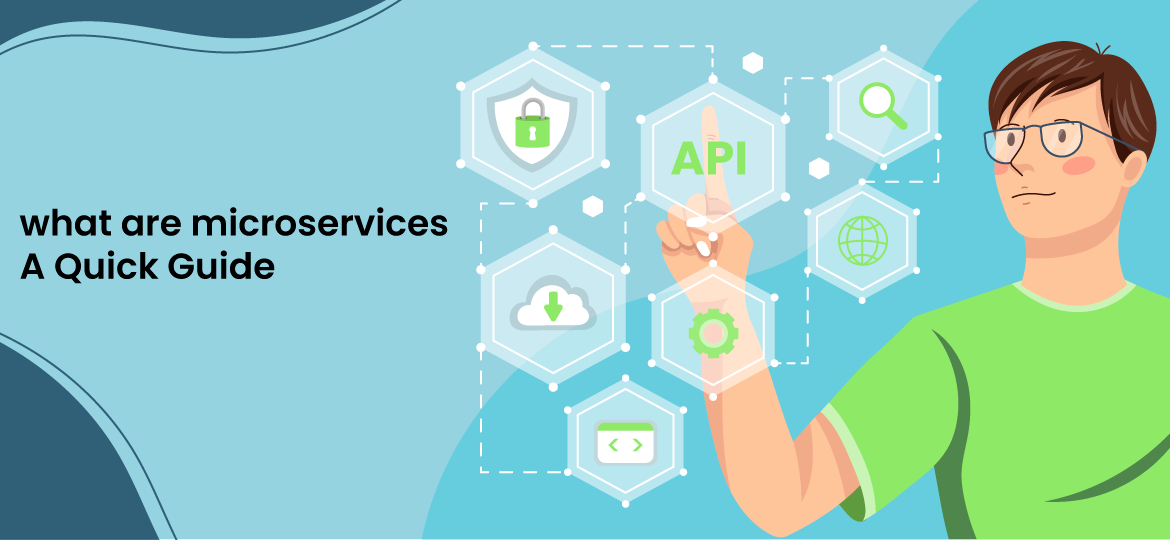The benefits and potential of microservices are recognized by both users and non-users in the current period and the real-time users’ confidence in the future of microservices is great. This may sound astonishing but reports say that 78% of current users say their business will likely increase the amount of money and effort invested in microservices and 56% of business bodies say that they are likely to adopt microservices in a couple of years.
“If you are working in an organization that places lots of restrictions on how developers can do their work, then microservices may not be for you.” quoted by Sam Newman
What Is Microservices In Simple Words?
Microservice is an ; architectural style where an extensive software application is built with separated segments and loosely coupled services. Here, every service performs individually for the focused business function and communicates with each other independently via predefined web interfaces.
Many organizational bodies in today’s market have embraced Conway’s Law to leverage the potentiality of dispersed teams and build efficient and effective microservice architecture.
When Should You Use Microservices?
Microservice is an ; architectural style where an extensive software application is built with separated segments and loosely coupled services. Here, every service performs individually for the focused business function and communicates with each other independently via predefined web interfaces.
Many organizational bodies in today’s market have embraced Conway’s Law to leverage the potentiality of dispersed teams and build efficient and effective microservice architecture.
- To adopt agility, manageability, scalability, and delivery and performance speed in the monolithic application
- To update your legacy applications in present-day’s programming languages or tech stacks to match with business trends, requirements, and solutions
- To predict the types of devices on which the app is going to run when the developers are unable to decide
- To support the incorporation with the help of a skilled data management team
- To use standalone modules across diverse channels
- To be compatible with a highly agile application development demanding accelerated speed of delivery and creativity
Key Benefits Of Microservices
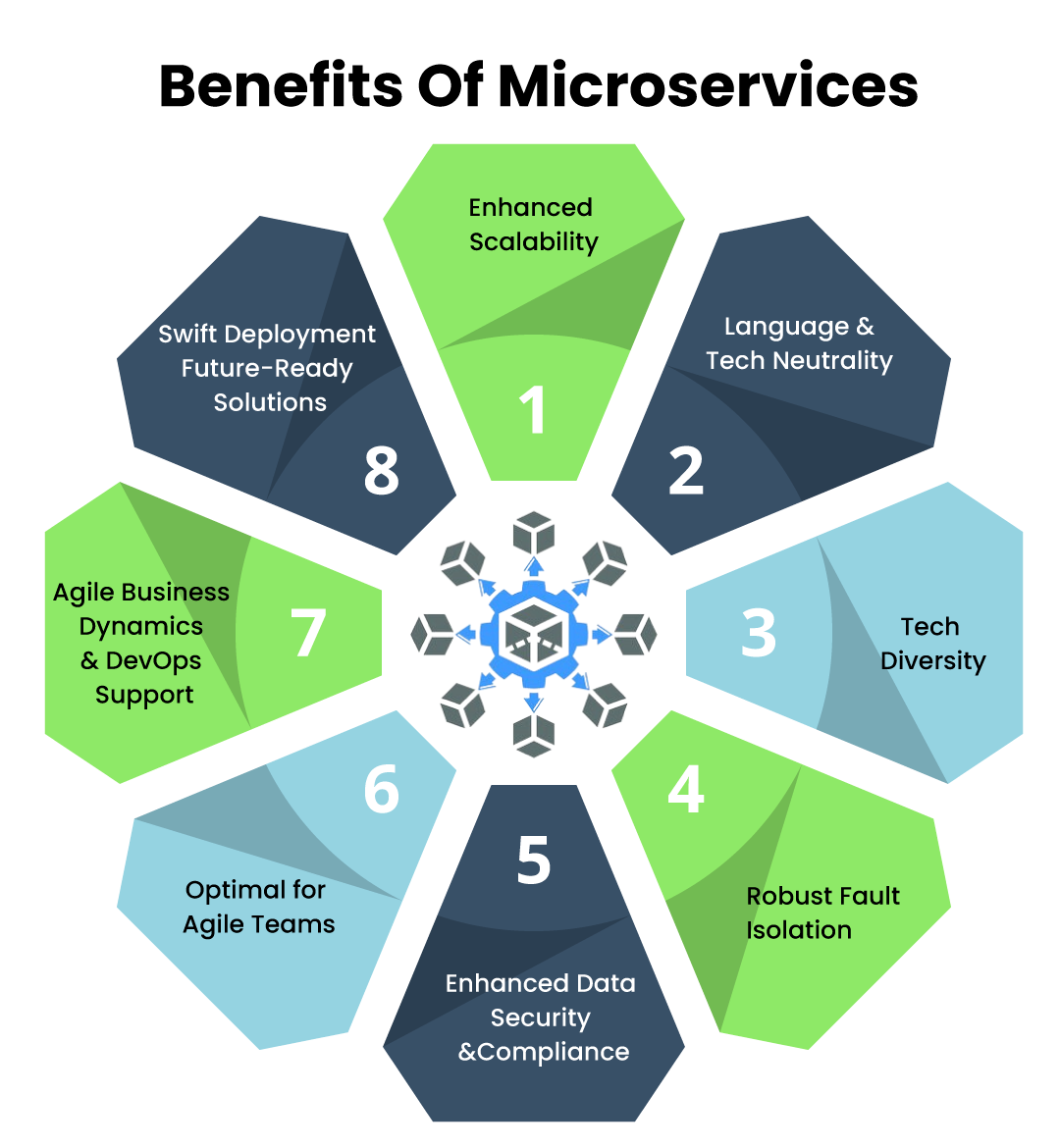
Agility and Affordability Scalability
With microservices, segments of various teams can work independently and scale the services as per priority to act within a predefined context, reducing the time of the development cycle, saving cost, and increasing outcome.
Higher- Quality End Product
Molding the larger chunk of components in various segmented parts helps concentrate on that part specifically. This approach simplifies the overall coding and testing process by focusing on just one at a time and increases the quality of software.
Real-Time Processing
A publish-subscribe framework enables the data processing in real-time. Eventually, extensible systems can go through and process a large number of data in real-time.
Data Isolation
It is much easier to perform schema updates in microservices as only a single part is affected, unlike monolithic applications where the data is shared among the application.
Enjoy Limitless Integration
As the processes are individually segmented into teams the integration of the services is seamlessly unaffected by time. Microservices make sure that the failure in one service doesn’t affect the overall application.
Main Steps To Introduce Microservices
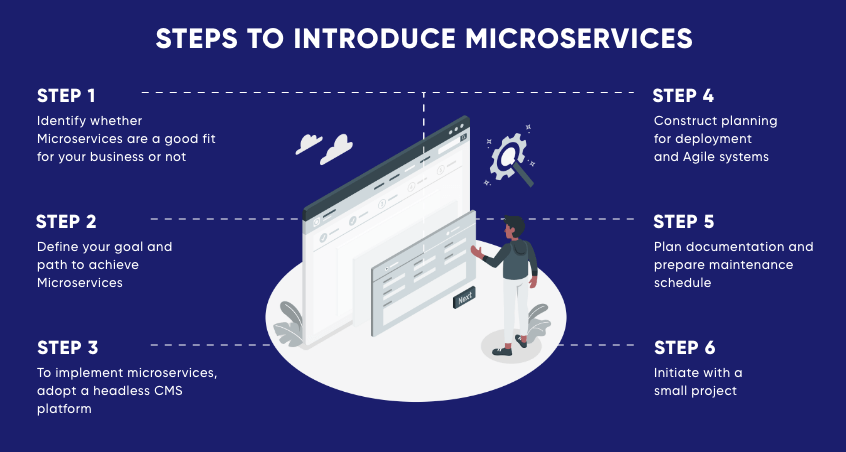
Here is a step-by-step process that elaborates how to introduce microservices into your tech stack following these steps will let you build a project with the use of microservice architecture to reach up to the goals.
Also Check:
STEP 1: Assessing Microservices Suitability for Your Business
Initially, you have to determine whether microservices match your business’s perspective and goals. Only after knowing the requirements, capabilities, and outcomes, you should move forward with implementation as the application process will be complex. So, it is mandatory to have the access to adequate software engineering skills and microservices expertise in your team.
If that is not the case, an already created simple application with a monolithic approach will be more suited for your team’s needs. If after determining you think that Microservices is the right ap
STEP 2: Crafting Microservices Goals and Strategies
If the business perspectives and microservices architecture is a good match then it comes to the point where microservices goals need to be defined. A goal map or path should be outlined and the flow of moving towards it should be defined. If you don’t have a plan ready for how this is going to work then because of Microservices’ individual nature to add multiple services may cause complexity and chaos. This step may vary from company to company as every business has different goals and different ways to reach them.
Even though you are building everything from scratch or transitioning from monolithic architecture, this step is important to define the goals and set the boundaries between the services.
STEP 3: Choose Headless CMS for Microservices Implementation
This headless architecture enables the development and deployment of the back-end independently of the front-end architecture. It simplifies the process of implementing microservices as you will be able to develop each service independently as well as makes it even more efficient.
This will give access to your team to build, optimize, deploy and manage the content modules without interfering with the design and development that goes around on different channels and devices.
Adapting to CMS will let you use the modern technologies independently without holding you back.
STEP 4: Agile Systems Deployment Essentials
A publish-subscribe framework enables the data processing in real-time. Eventually, extensible systems can go through and process a large number of data in real-time.
STEP 5: Doc Plan & Maintenance Schedule
Numerous microservices performing concurrently in various departments might create a state of fuss for the based marketing platform.
Planning for ongoing documentation and maintenance as monitoring and recording errors can keep all the parts moving smoothly together. This culture can promote the concept of keeping high-quality technical documentation and algorithms which go conjointly with the coding.
STEP 6: Initiate A Small Project
After following the process make sure that everything is in its place and release a small microservice project at first before implementing it completely.
It doesn’t matter if you are transitioning your entire business with microservice architecture or just adding a few services, swiftly rolling out just one of it initially can give a better understanding of its requirements and run the decoupled architecture efficiently.
With this, you will be able to figure out where you are lacking or failing and learn how to hold out in a controlled environment.
Microservices VS Monolithic
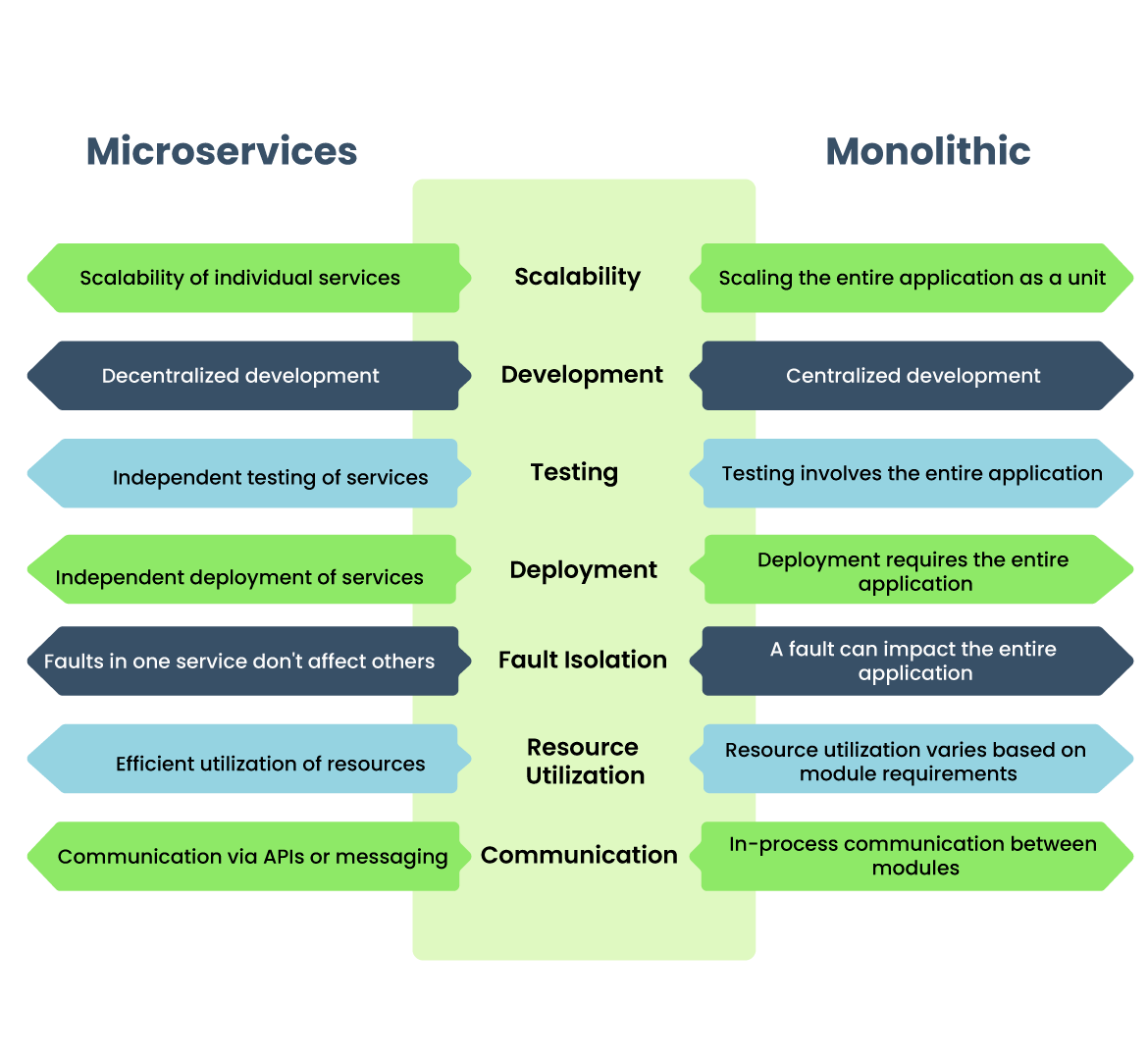
Explaining monolithic architecture – An application developed with monolithic works as a single unit, where all features, functionality, and segments are closely-bounded for integration, deployment, and development.
When comparing Microservices with SOA there are a few points we should focus on:
Design
In microservices, independent services communicate via APIs. Monolithic is designed as a complex app encompassing several tightly-coupled functions.
Scalability
Microservices are independently scalable but in monolithic it is a bit challenging due to dependencies between services & reusable sub-components.
Agility
While the microservices have high operational agility, in monolithic it is difficult to achieve operational agility.
Also Check:
Service startup
The process of service start-up is relatively more rapid in microservices than in monolithic.
Data consistency
Data consistency is quite more difficult to achieve in microservices than in monolithic.
Team communication
Monolithic does have comparatively straightforward team communication than microservices.
Finding failure points
In the architecture of microservices, it is quite difficult to find failure points but the same process is quick and easy in monolithic.
Microservices Vs Monolithic Pros And Cons
| Microservices | Monolithic |
|---|---|
| Easily scalable, each service can scale independently. | Limited scalability, scaling the entire application. |
| Offers flexibility in technology choices for each service. | Limited flexibility, uniform technology stack. |
| Independent development for each service can lead to faster development. | Development may be slower, especially for large projects. |
| Faults in one service don't affect the entire system. | A fault in one module can impact the entire application. |
| Efficient resource utilization, as resources are allocated based on service needs. | Resources may be over-allocated to support the entire application. |
Microservices VS SOA
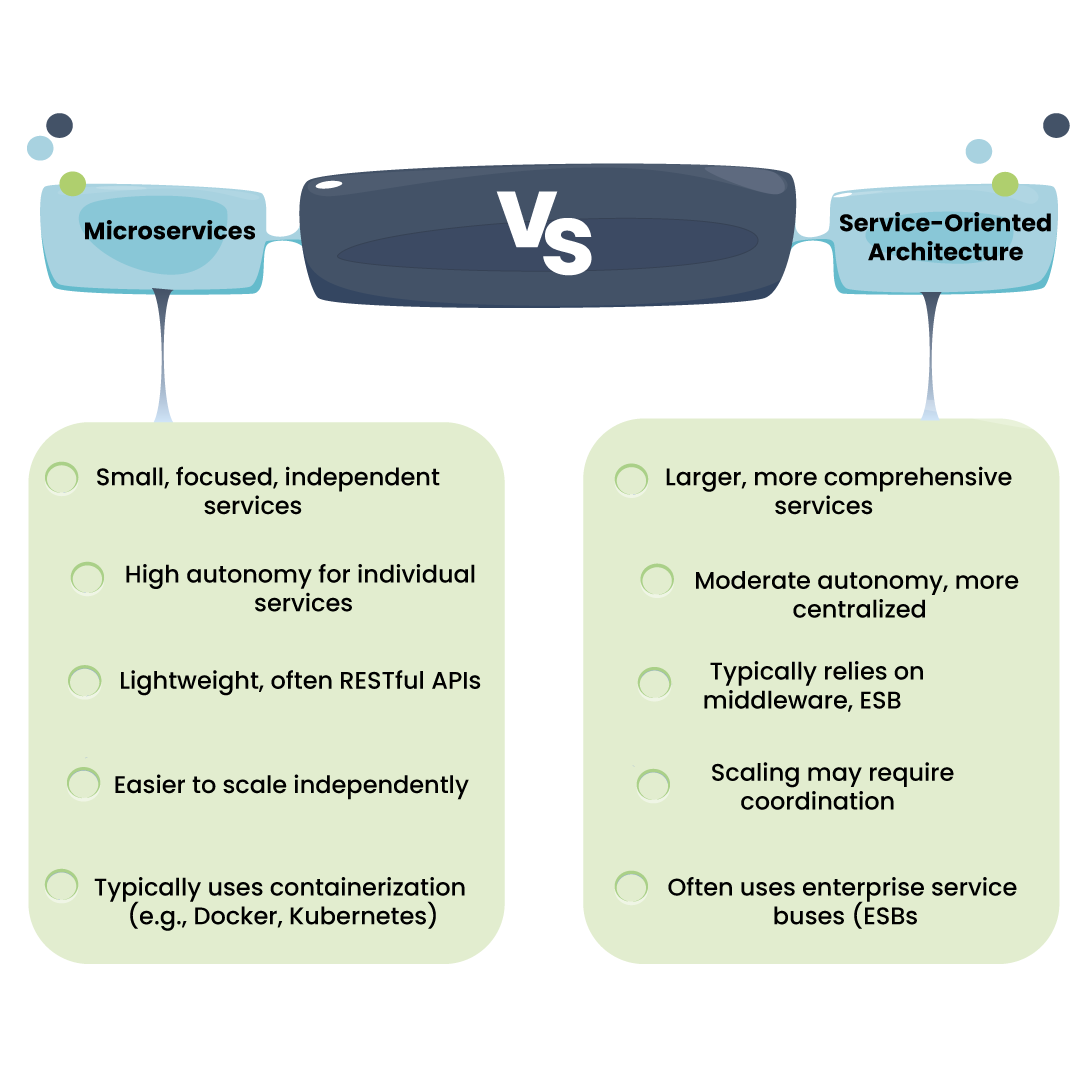
Service-oriented architecture (SOA)– Created as a response to the traditional approach for decoupling an application into smaller segments. And to meet specific business requirements these individual service segments intercommunicate. It is often considered by many developers that microservices are a subtype of SOA, while few insist that each works on a different set of problems.
When comparing Microservices with SOA there are a few points we should focus on:
Design
In microservices design patterns, services are built-in smaller units. While in SOA services size can vary from small to large.
Scalability
In terms of scalability, microservices are independent but in SOA it is a bit challenging due to dependencies between services & reusable sub-components.
Data Storage
Each microservices can have independent data storage, unlike SOA which involves sharing data storage between services.
Component sharing
SOA does involve component sharing but microservices do not involve component sharing generally.
Deployment
The deployment process in a microservices architecture is very quick and easy unlike SOA’s less flexible deployment and it is one of its best characteristics.
Remote services
Microservices more often use REST and JMS remote services and likewise, SOA uses protocols like SOAP and AMQP.
Examples Of Microservices
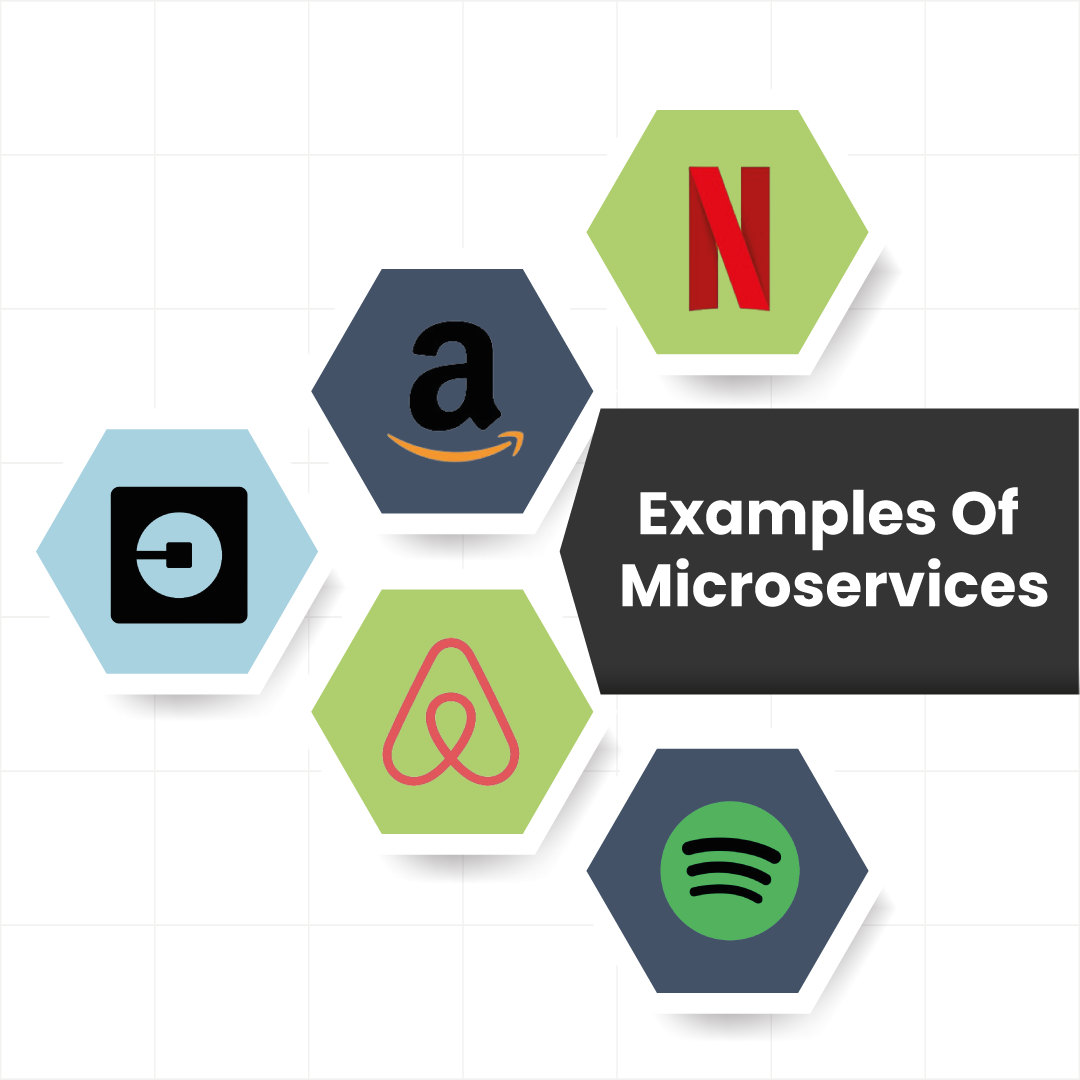
Microservices in general can be proven valuable for the development and growth in various sectors like healthcare, online marketplace, eCommerce, social media networks, finance, and many more. To understand the concept of how it can be utilized practically we can see the below-mentioned usages:
Including new desired functionality to a large legacy system
Accumulation, composition, and analysis of a data flow for machine learning environments
To handle big data, it provides scalability and control
It’s one of the uses is to enable advanced analytics environments to validate their updated computational models with the help of AB and multivariate testing
Only because of the microservices architecture examples discussed below it was possible to make the world understand how the transition from monolith to it could make a change!
Netflix
Amazon
Best Buy
Conclusion
Microservices architecture is the nearest perfect solution to the digitally developing world which needs to deliver faster functionality and reliability. However, the transition from monolithic to it can be lengthy and tedious. Its suitability depends on the project scale and requirements. Usually, they are preferable to modernize legacy systems and also for cost reductions, enhanced collaboration, integrations, and data consistencies. Questions about microservices or need assistance for your project? Contact us for tailored insights and support.
FAQs
When should we use microservices?
Microservices can be used to make a change to functionality when the organization needs it and also to deploy that functionality in a way that it doesn’t affect the rest of the system.
Do microservices have a future?
The microservices architecture market is growing rapidly at a CAGR of 17 percent, putting it on pace to reach $33 billion by 2023 as stated by the reports.
